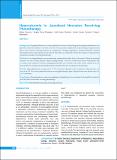Please use this identifier to cite or link to this item:
https://hdl.handle.net/20.500.14356/1102| Title: | Hypocalcemia in Jaundiced Neonates Receiving Phototherapy |
| Authors: | Shrestha, Sabina Dhungana, Sangita Shrestha, Sujit Kumar Shrestha, Gentle Sunder Kakshapati, Prayash |
| Citation: | ShresthaS., DhunganaS., ShresthaS. K., ShresthaG. S., & KakshapatiP. (2021). Hypocalcemia in Jaundiced Neonates Receiving Phototherapy. Journal of Nepal Health Research Council, 19(2), 284-287. https://doi.org/10.33314/jnhrc.v19i2.3423 |
| Issue Date: | 2021 |
| Publisher: | ShresthaS., DhunganaS., ShresthaS. K., ShresthaG. S., & KakshapatiP. (2021). Hypocalcemia in Jaundiced Neonates Receiving Phototherapy. Journal of Nepal Health Research Council, 19(2), 284-287. https://doi.org/10.33314/jnhrc.v19i2.3423 |
| Article Type: | Original Article |
| Keywords: | Hyperbilirubinemia hypocalcemia phototherapy |
| Series/Report no.: | Apr-June, 2021;3423 |
| Abstract: | Abstract Background: Hyperbilirubinemia is a common problem in neonates. Phototherapy and exchange transfusion are the primary treatment modalities. Less known, but one of the potential complications of phototherapy is hypocalcemia. Most of the neonates with hypocalcemia are asymptomatic. Though asymptomatic, treatment should be initiated immediately when serum calcium level is reduced. This study was conducted to detect the incidence of hypocalcemia in jaundiced neonates receiving phototherapy. Methods: It is a hospital-based cross-sectional study conducted from May 2020 to December 2020 in the neonatal intensive care unit of Nepal Medical College Teaching Hospital. A total of 128 full-term neonates with jaundice and a normal serum calcium level before initiating phototherapy were enrolled in the study. Serum calcium level was measured before starting conventional phototherapy and after 48 hours of continuous phototherapy. Results: Hyperbilirubinemia was present in 23.3% of neonates admitted to the neonatal unit. Hypocalcemia was seen in 26 (20.3%) of term jaundiced neonates receiving phototherapy. Signs of hypocalcemia were present only in 3 (2.3%) neonates. Conclusions: Hypocalcemia is a common complication of phototherapy. Serum calcium levels should be monitored in all the full-term neonates receiving phototherapy. Keywords: Hyperbilirubinemia; hypocalcemia; phototherapy |
| Description: | Original Article |
| URI: | http://103.69.126.140:8080/handle/20.500.14356/1102 |
| ISSN: | Print ISSN: 1727-5482; Online ISSN: 1999-6217 |
| Appears in Collections: | Vol. 19 No. 2 (2021): Vol 19 No 2 Issue 51 Apr-Jun 2021 |
Files in This Item:
| File | Description | Size | Format | |
|---|---|---|---|---|
| 3423-Manuscript-23764-1-10-20210907.pdf | Fulltext Download | 177.6 kB | Adobe PDF |  View/Open |
Items in DSpace are protected by copyright, with all rights reserved, unless otherwise indicated.
